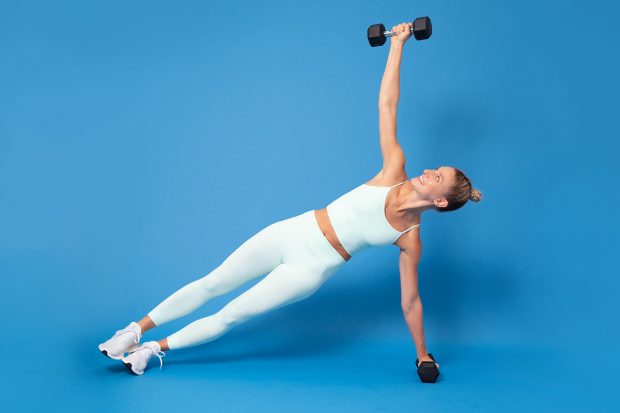Want to exercise longer and harder? Increase your stamina and endurance.

When you think of the words “stamina” and “endurance,” you may presume it only implies to runners. After all, runners need to run for long periods of time while covering many miles.
But endurance means different things for different people and it’s certainly needed to train harder and longer no matter what activity you’re into.
Endurance is your ability to carry out any given physical task for an extended period of time.
Your heart and muscles are the two contributing forces responsible for your level of endurance. While they’re both crucial in helping you push through tough workouts, it’s important to understand the difference between cardio and muscular endurance, especially to reach your fitness goals.
In this article, you’ll discover 7 endurance-boosting strategies that have worked for fitness fanatics and athletes from every walk of life. These proven strategies are guaranteed to help you reach all of your health and fitness goals.
What’s Cardiovascular Endurance?

Before we dig into the 7 endurance-boosting strategies, let’s first discuss the difference between cardiovascular endurance and muscular endurance.
Cardiovascular endurance (aerobic fitness) is the ability of your cardiorespiratory system (heart, blood vessels, lungs and airways) to keep your body active for a long period of time.
During aerobic exercise (jogging, biking, climbing stairs), your body uses oxygen to supply your working muscles with energy. Aerobic exercise can be performed for long periods of time depending on how fit you are.
Most of us picture marathon runners when thinking of people with high levels of endurance. But people who work out regularly also have solid levels of cardiovascular endurance.
What’s Muscular Endurance?

Muscular endurance is the ability of a single muscle or group of muscles to perform repeated contractions against a load for an extended period of time. In plain language, this means the number of reps you can perform for any given exercise without breaking form.
A good example of a single muscle exercise (isolated movement) would be the dumbbell bicep curl repeated for a specific number of reps or time. An example of a muscle group exercise (compound movement) would be a dumbbell squat and press (thruster), where multiple muscles are recruited to perform the movement.
The more muscles recruited, the more the exercise will tax both your muscular and your cardiovascular system.
A good indicator of your overall strength is to test your muscular endurance. Perform as many push-ups, squats or sit-ups as you can in 60 seconds. Then, check your baseline measures against the industry standard to determine your fitness level.
Which One Is Better?
It might come as no surprise but neither one is better. For optimal levels of health and fitness, you’ll need a combination of both.
For example, running requires cardiovascular endurance to ensure your muscles get enough oxygen. But you’ll also need muscular endurance to ensure your legs are strong enough to keep moving, especially on hilly terrain.
Below, you’ll find 7 ways to boost your cardiovascular and muscle endurance simultaneously.
#1 Combine Strength Training Days With Cardio Days
The equation is actually quite simple—the more muscles you recruit and fire, the more you’ll challenge your cardiovascular system. Instead of solely focusing on cardio workouts, make sure to add strength training into your workout routine. Most people reserve one day for strength and another day for cardio but try combining the two instead.
Try mountain climbers for a minute followed by dumbbell squats, shoulder presses and sit-ups. Keep repeating. Another good example—dumbbell lunges followed by bodyweight plyo lunges on repeat.
If you’re not that creative, head to fitness apps like Gymondo, where you’ll find a huge variety of workouts that combine cardio and strength training.
#2 Reduce the Amount of Rest Between Sets
If your goal is to increase your stamina and endurance, shorten your breaks between sets. By the end of each set, your muscles should be burning—you should be breathing heavily and sweating. Only take a break if you physically can’t continue.
Try selecting a series of cardio and strength exercises—10 push-ups, 10 squat jumps, 10 mountain climbers, 10 sit-ups. Depending on your fitness level, do 3-5 rounds of the series back-to-back with minimal rest between rounds.
#3 Do Fast-Paced, High-Intensity Strength Training
When you use dumbbells at an extremely rapid pace, it will not only improve your strength, it will also improve your endurance. In fact, it’s one of the best ways to boost your metabolism, especially since it recruits more fast-twitch muscle fibers. Fast-twitch muscle fibers produce bigger and more powerful forces but for shorter durations and fatigue quickly. They’re vital for anaerobic activities like sprinting and jumping.
Related: How Your Metabolism Changes in Your 20s, 30s and 40s
If you only do endurance-related activities, you’ll only recruit slow-twitch muscle fibers. Slow-twitch muscle fibers are fatigue-resistant and are focused on sustained, smaller movements and postural control. They contain more mitochondria and myoglobin and are aerobic in nature.
Most people make the mistake of only doing cardio exercises because they burn a lot of calories. But an excessive amount of endurance training may actually slow down your metabolism because it starts to eat away at your muscle tissue. Strength training is a key component of metabolism. The more muscle you have, the higher your metabolic rate.
Add fast-paced, high-intensity strength training to your workout routine to increase your metabolism.
#4 Choose Compound Movements Over Isolated Exercises
The more muscles involved in a specific exercise, the more you’ll tax your cardiovascular and muscular endurance. Compound movements—moves that require multiple muscle groups—have all kinds of benefits. Not only are they harder, they require more concentration, burn more calories and stimulate your energy system to increase stamina, endurance and strength. Common compound exercises include squats, push-ups and thrusters.
It’s important to note that you don’t necessarily need dumbbells to strength train or to perform compound movements. You can get a great strength training workout in by using your own body weight.
#5 Switch up Your Routine
We talk so much about the importance of developing a consistent workout routine, but once you get in the habit, it’s essential to switch things up. Our bodies are smart—they adapt to exercise over time. If you continually do the same exercise routine, you’ll eventually hit a plateau and stop progressing. In fact, it takes about 2 weeks for the body to adapt. So, every 2 weeks, you should switch things up.
Related: 3 Strategies to Get You Through Your Next Workout Even When You Don’t Want to
If you’re an avid jogger, add boxing to the mix. If you’re a regular cyclist, try running stairs instead. To ensure you continually see gains, move your muscles in different ways. This way, you won’t develop overuse injuries or hit plateaus in your training. Plus, it’s way more motivating since it keeps your mind guessing!
#6 Add Hybrid Movements to Your Workout Routine
Hybrid movements take compound exercises to the next level. They combine two compound movements so you can work even more muscles at once—think lunge-burpees or push-ups with mountain climbers. You’ll get more bang for your buck in less time with hybrid movements.
The more muscles you can get working in one movement, the more you’ll improve your cardiovascular and muscular endurance, which will enhance your overall stamina much faster.
#7 Add Explosive Movements to Your Workouts
Explosive movements not only build strength but also require a lot of energy, endurance and stamina. Once you improve your explosiveness, you’ll move faster and with more ease. Exercises like burpees, plyo lunges, squat jumps, long jumps, tuck jumps and power push-ups are great explosive moves to add to your workout routine.
Takeaway
Whether your goal is to lose weight, gain strength, burn calories or intensify your workouts, combine strength and cardio into your training routine. Not only will you have more fun during your training sessions, you’ll see results faster!
Ready to increase your stamina and endurance? Explore 30+ fitness programs and 300+ workouts that combine both endurance- and strength-based training to get you the results you want. Start your free trial with Gymondo today.










Kommentar schreiben